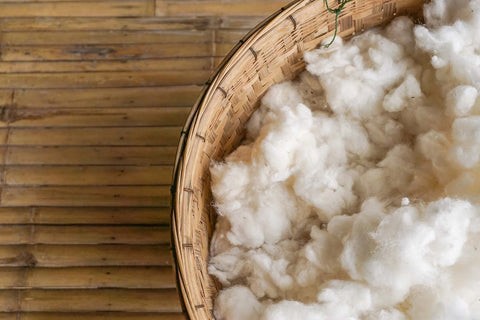No products in the cart.
News
What is kapok and why would you want it in your pillow?
What is kapok?
Kapok (pronounced “kaypock”) is a natural occurring fibre that grows on the ceiba pentandra tree, also known as the kapok tree. These rainforest trees grow in hot climates, commonly found in places like Southeast Asia and Central America, and also being found in some parts of Mexico, India, Australia, and even Hawaii. Kapok trees can grow as tall as 200 metres high and continue growing for sometimes centuries without human intervention, making them a sustainable alternative to synthetic materials. Kapok is commonly processed into fabrics or used in its natural form as a stuffing for pillows or bedding.

How kapok is harvested
That kapok fibre itself grows inside pods—or seeds—that grow on the kapok tree. These pods can be harvested by removing them from the trees, or by opening the pods that naturally fall to the ground. Harvesting the kapok doesn’t harm the tree itself or impact its ability to regenerate the fibre. Once collected, it’s common for kapok to be classified into different grades (or qualities). Each grade has a similar feel but is classified by its colour (from white to yellow) and the amount of organic matter (like seeds or stems) that are found within the kapok.

What does kapok feel like?
In its natural form, kapok is a fluffy material that has a similar look and feel to raw cotton and is sometimes referred to as silk-cotton. In pillows, kapok is often cited as having a similar feeling to down, but it also has a soft and plush similar feeling to a high quality down alternative. Just like traditional pillow materials like down or polyester fill, kapok pillows can be fluffed up to maintain their shape over time.

What are the benefits of kapok?
Being naturally hypoallergenic, kapok pillows or bedding are excellent choices for anyone with allergies or sensitivities. While materials like down and polyester (including the kind used in down alternative) can be attractive for dust mites, kapok has the added benefit of being naturally dust mite resistant. You might think your pillow looks clean, but each night, it collects dead skin cells that dust mites love to feed on (gross). By reducing dust mites in your bed, you’re reducing a common allergen in your home — and could wake up breathing easier.
The sustainability benefits of kapok
Although kapok has been harvested for clothing and bedding for centuries, it’s been gaining popularity in recent years as a sustainable alternative to common materials like polyester or cotton. The fashion industry has been picking up on the benefits of kapok, with more fashion brands (such as Frank and Oak) introducing kapok clothing lines. With both consumers and brands looking to reduce their carbon footprint, kapok fits the bill.
The ceiba trees continue to grow naturally for years without human intervention, making it a renewable resource. With just natural rainfall — and no fertilizer or pesticides — the trees produce kapok (and clean air) season after season. In order to be used in a fashion material, kapok needs very little processing, setting it apart from other common fashion materials that could take tens of thousands of gallons of water to be processed. When used in its natural form in a pillow — like the Henrie kapok pillow — no processing is used other than removing seeds or other organic matter from the kapok.
Why use kapok in pillows?
Kapok has been commonly used in pillows since ancient times, having been a popular pillow filling in the communities in which the kapok trees grow. In pillows, kapok is a soft vegan stuffing that is naturally hypoallergenic, and a natural alternative to less sustainable options. With a typical shelf life of up to 2 years, pillows can become a more conscious option by being filled with a biodegradable filling like kapok.

Its low footprint combined with its comfy feel made it a no-brainer to make kapok a core ingredient in the Henrie pillow. After all, a great night’s sleep should never come with compromise.
Natural kapok fiber is being supply at Safimex company. If you are looking for this item, please visit to our Alibaba website: https://www.alibaba.com/product-detail/NATURAL-KAPOK-FIBER-FROM-VIETNAM-VIETNAMESE_62003370253.html?spm=a2747.manage.0.0.cd9e2c3cWlF4CA
Source: Henrie
SAFIMEX JOINT STOCK COMPANY
Head Office: 216/20a Duong Ba Trac Street, Ward 2, District 8, Hochiminh City, Vietnam.
Tel: (+84)-(28)-3636 2388 | (+84)-(28)-3636 2399 | Website: https://safimex.com/
